Ellis,J. Pressure transients in water engineering, A guide to analysis and interpretation of behaviour
Подождите немного. Документ загружается.

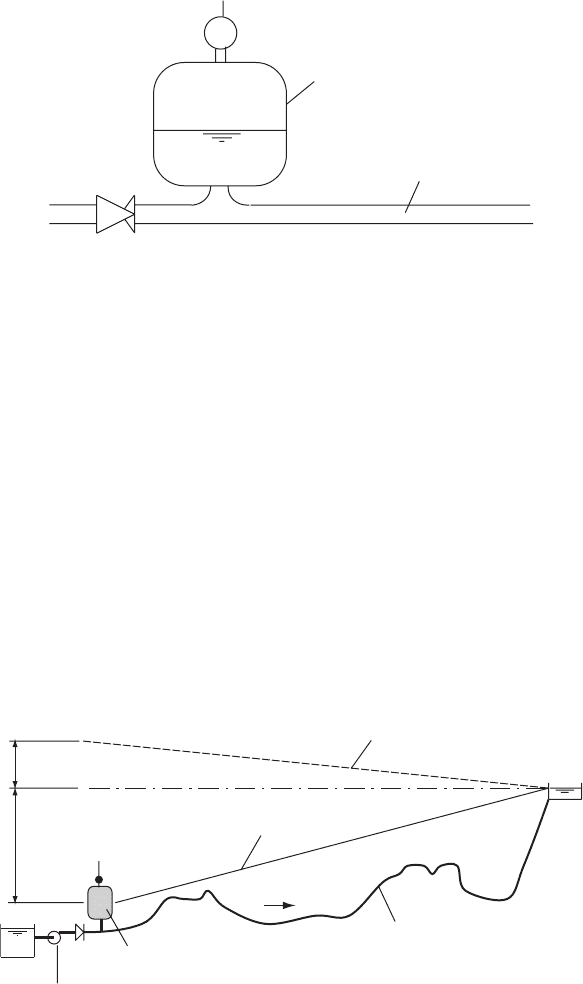
level. Negligible head loss is assumed through the air valve during
inflow. It is also assumed that negligible deceleration of the water
column has occurred prior to air valve operation and that the friction
factor f and the elevation difference z remain essentially constant.
Equation (2.1) can be written:
L=g dV=dt þ fLV
2
=ð2gDÞþz ¼ 0 ð2:1Þ
or
L=g dV=dVol dVol=dt þ fL=DV
2
=ð2gÞþz ¼ 0
but
dVol=dt ¼ Q ¼ VA and LA ¼ Vol
p
therefore
Vol
p
=gV dV=dVol þ fL=DV
2
=ð2gÞþz ¼ 0
322
Rising main
Air valve
Buffer tank
Air vol.
Fig. 17.22. Schematic of buffer tank
Steady pumping piezometric line
hf = steady flow head loss
z
Minimum piezometric line
Buffer tank
Pum
p
in
g
station
Rising main
Diameter = D
Length = L
Cross-section = A
Air valve
V
M
M
Fig. 17.23. Hydraulic gradient at buffer tank
Pressure transients in water engineering
Writing e ¼ V
2
=ð2gÞ , then
Vol
p
de=dVol þ fL=De þ z ¼ 0
rearranging,
de=ðfL=De þ zÞþdVol=Vol
p
¼ 0
and integrating,
ð
de=ðfL=De þ zÞþ1=Vol
p
ð
dVol ¼ constant
or
fL=DVol=Vol
p
þ lnðfL=De þ zÞ¼constant ð17:9aÞ
Initial velocity is V
o
and e ¼ e
o
¼ V
2
o
=ð2gÞ while Vol ¼ 0. Substituting
then,
0 þ lnðfL=De
o
þ zÞ¼constant
When air volume has reached its maximum as flow downstream of
the air volume comes to rest then, e ¼ 0 and Vol ¼ Vol
max
. Then,
fL=DVol
max
=Vol
p
þ lnðzÞ¼lnðfL=De
o
þ zÞ
rearranging,
fL=DVol
max
=Vol
p
¼ lnfðfL=De
o
þ zÞ=zg
and finally,
Vol
max
=Vol
p
¼ D=ðfLÞlnf1 þ hf=zgð17:9bÞ
Equation (17.9b) was presented by Livingston in 1969. Static head is
a function of volume, and as air volume increases z will increase. Where
overall static head is appreciable, any variation in z will be relatively
unimportant. On the other hand, if say a vertical buffer tank is selected
for a low head installation, the variation in z may have a significant
influence on overall static. In these circumstances it may be worthwhile
to insert extremes of z into the equation to assess the importance of
changes in z. These extremes could include values of static head
measured from the top and bottom of the buffer tank.
Equation (17.9b) can also be used to estimate air volume when no
tank is included but the air valve sits directly on top of the pipeline.
The variation in z is likely to be more modest in this situation, with
the air volume stored within the pipeline itself.
323
Air valves
Pipeline profiles in low-head applications may have a number of high
points along the route. Should air valves operate at intermediate
summits, the effect will be to reduce the actual air volume admitted
to the pipeline or buffer tank at the start of the main, from the value
calculated from equation (17.9b).
324
Pressure transients in water engineering
18
Air and gas
In Chapter 17 it was described how the introduction of air into a
pipeline system may be used to beneficial effect, namely the avoidance
or limitation of serious vacuum during a pressure transient event. It
was also described how if not carefully regulated, serious secondary
hydraulic transients could occur following venting of air and/or gas
through air valves. The present chapter presents several case studies
to illustrate circumstances in which air or gas masses can prove
problematic.
18.1 Pump start-up with an air-filled riser
The first of these studies concerns the common example of a pumping
station in which an air column exists between the pump and a down-
stream check valve. Pumping station arrangements may loosely be
described as being of two types. First there is the wet well/dry well
configuration. In this the check valve is a short distance downstream
of the pump. The pipeline within the pumping station and along the
initial parts of a rising main usually remains liquid-filled even under
modest static head conditions. Since no air or gas should be present
in the riser column downstream of the check valve, no particular
problem of air removal is anticipated during pump start-up.
The alternative arrangement, and one which is relatively common
nowadays, is to have a wet well containing submersible pumps
(Fig. 18.1). A vertical riser extends above sump water level to a horizon-
tally placed check valve. An air valve is usually sited just upstream of
the check valve. Downstream of this check valve the pumping station
pipework may include other pump branch connections where a multi-
pump installation is involved. Figure 18.2 shows the downstream
325
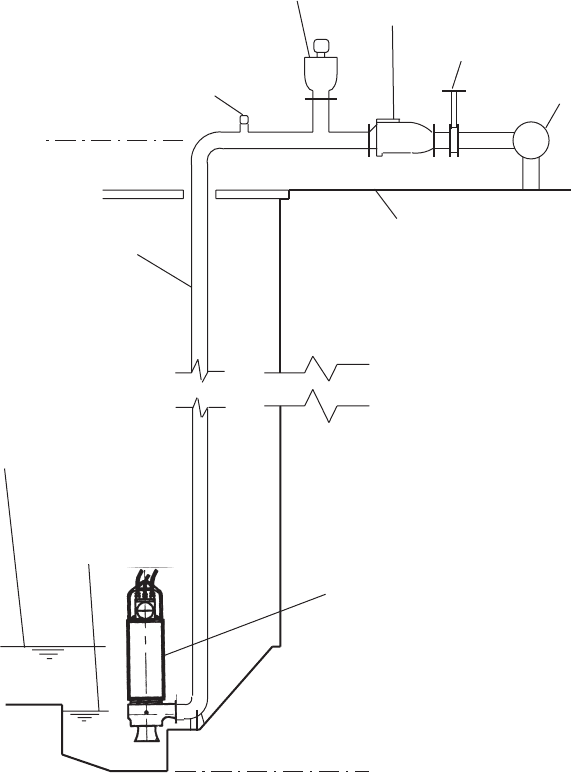
arrangement for a fairly typical submersible pump installation. In this
figure, branch pipes from two of four foul sewage pumps can be seen.
A sewage air valve is included upstream of a swing-check valve in
each of these discharge branches.
When a pump is idle, the riser upstream of the check valve will be
filled with air down to the water level in the wet well or sump. This
configuration also occurs in boreholes where the check valve is located
at the wellhead. The problem of an air-filled riser should not arise in
326
–17.74 mAOD
M
M
M
WPL SWALLOWGLIDE
SRVS 200DS (4 off)
+6.0 mAOD finished floor level
Stop level pump 1,
2 and 3 = –16.99
Start levels:
pump 3 = –16.025
pump 2 = –16.125
pump 1 = –16.225
DN 350 riser
12.5 mm tapping for
pressure transducer
c.l. = 6.803 mAOD
350/500 tee
DN 350 knife gate valve
DN 350 swing check valve
Dual-orifice EPEX air valve
Fig. 18.1. Submersible pump arrangement
Pressure transients in water engineering
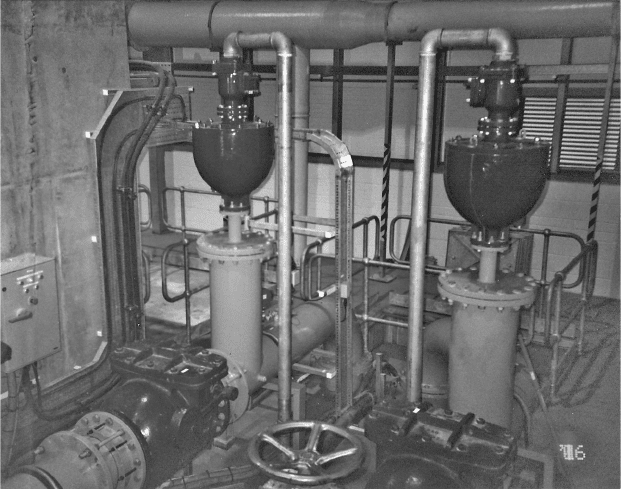
these borehole pumping installations where the check valve is sited
directly on top of the borehole pump.
Hydraulic transients associated with priming of an air-filled riser
pipe following start of a borehole pump was considered of sufficient
importance to warrant particular attention and earlier studies have
examined potential problems.
Downstream of each check valve, flow travels through DN 350 lines
which rise vertically to join a DN 500 pipe at elevation þ9.9 mAOD as
shown in Fig. 18.3. A single-orifice air release valve is included at the
downstream end of this gradually rising pipe. After the DN 500 pipe
descends vertically, two further foul pump connections are made
prior to start of the rising main.
A typical pump curve for the submersible sewage pumps is as shown
in Fig. 18.4 with the duty head reflecting the design static lift and also
system resistance losses. When a submersible pump or a borehole pump
is operated with an air-filled riser, the static head experienced at the
pump at start is initially zero. If a direct pump start is assumed, flow
rate at this stage can be considerably in excess of the design discharge
and the pump motor has to be able to accommodate the higher power
demand associated with this phase of start-up. The riser pipe will
327
Fig. 18.2. Air valves and non-return valves at submersible pumping station
Air and gas

328
350/500 tee for
foul pump connection
+6.0 mAOD
DN 350 line from
foul pump
c.l. = +9.9 mAOD
Rise
DN 500 cross-over pipe
Single-orifice air
release valve
Odour pipe to
wet well
To rising main
Fig. 18.3. Pipework downstream of non-return valve
H
Q
Z
Speed necessary
to just fill riser
N = 25%
N = 50%
N = 75%
N = 100%
Duty point
Duty flow
Direct start
riser filling
Flow when air valve closes
Maximum flow – riser empt
y
Loss in riser
Loss through
air valve
Fig. 18.4. Pump performance against speed relationships
Pressure transients in water engineering
progressively become filled, with liquid level and static head at the
pump increasing and discharge reducing. The air column above the
water surface in the riser will become smaller, partly through compres-
sion but mainly as a result of venting through the air valve located at
the top of the riser. Preferred location for the air valve is downstream
of the 908 bend. During the venting process, pressure rise at the air
valve should not be too great. An excessive pressure rise upstream of
the check valve may overcome the downstream static head, allowing
the check valve to crack open and air to escape into the downstream
line. Often a typical large-orifice air valve would be installed to
ensure adequate air venting capacity.
When all air or gas has finally been purged, the air valve will shut and
the differential flow rate upstream and downstream of the check valve
will abruptly be eliminated. Downstream of the initially closed check
valve, velocity is zero and the upstream velocity will be given by the
operating point on the pump H—Q curve at the moment of valve
closure (Fig. 18.4). This upstream velocity will still be greater than
design velocity. An indication of the sudden head rise associated with
the process of velocity equalisation after air valve closure can be
obtained as follows.
From the Cþ characteristic arriving upstream of the check valve
(Fig. 18.5):
V
u=s
þ g=aH
u=s
¼ Jþ
where V
u=s
and H
u=s
are given essentially by the pump operating point
(Fig. 18.4), ignoring riser losses and head loss through the air valve.
From the C characteristic arriving on the downstream side of the
check valve (Fig. 18.5):
0 g=aH
d=s
¼ J
where H
d=s
is the prevailing head downstream of the check valve. If no
other pump is already operating, H
d=s
will be the static head. Where
pumps are already running, H
d=s
will be given by the appropriate
point on the system curve.
When flow is abruptly equalised, common velocity V is given by:
V ¼ðJþþJÞ=2 ¼ðV
u=s
þ g=aðH
u=s
H
d=s
ÞÞ=2
The transient pressure H when upstream and downstream water
columns meet is given by:
H ¼ðJþJÞ=ð2g=aÞ¼½V
u=s
þ g=aðH
u=s
þ H
d=s
Þ=ð2g=aÞ
329
Air and gas
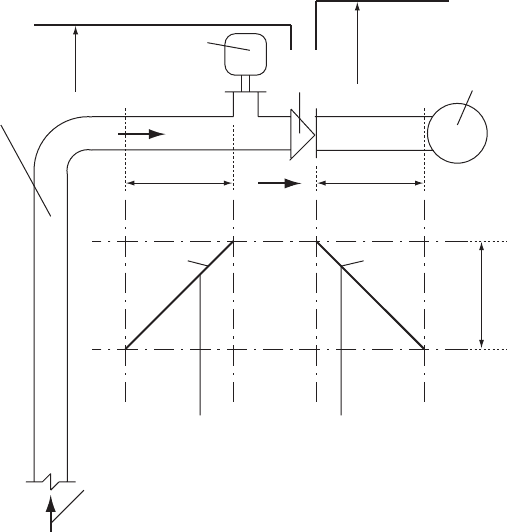
or
H ¼ aV
u=s
=ð2gÞþðH
u=s
þ H
d=s
Þ=2 ð18:1Þ
This head rise H can be very considerable and unacceptable.
Figure 18.6 shows an example of predicted velocity in the filling riser
of Fig. 18.1. The pump reaches design speed in 1.0 s and a maximum
velocity of 3.2 m/s is developed. As the riser fills, head at the pump
delivery increases and pump operation gradually moves back up its
performance curve (Fig. 18.4), to produce a reduced flow rate. Velocity
continues to decrease gradually until the riser is filled and the air valve
shuts. The velocities upstream and downstream of the air valve con-
nection are abruptly equalised and a high-frequency transient occurs.
Eventually a steady velocity of <1.0 m/s is produced. Head changes
at the air valve connection for this 1 s pump start are contained in
Fig. 18.7. Only small changes occur until the air valve shuts when
upstream and downstream velocities are equalised. An abrupt head
rise develops reaching a peak of 180 mAOD. The high-frequency
transient dissipates quite rapidly to leave a steady operating head of
330
+
NRV
Discharge
header
H
d/s
H
u/s
V
u/s
Dx
Dt
Dx
V
d/s
= 0.0
C+
J+ = V
u/s
+ g/aH
u/s
J– = 0.0 – g/aH
d/s
C–
Air valve
Riser
From pump
Fig. 18.5. Flow conditions during air venting
Pressure transients in water engineering
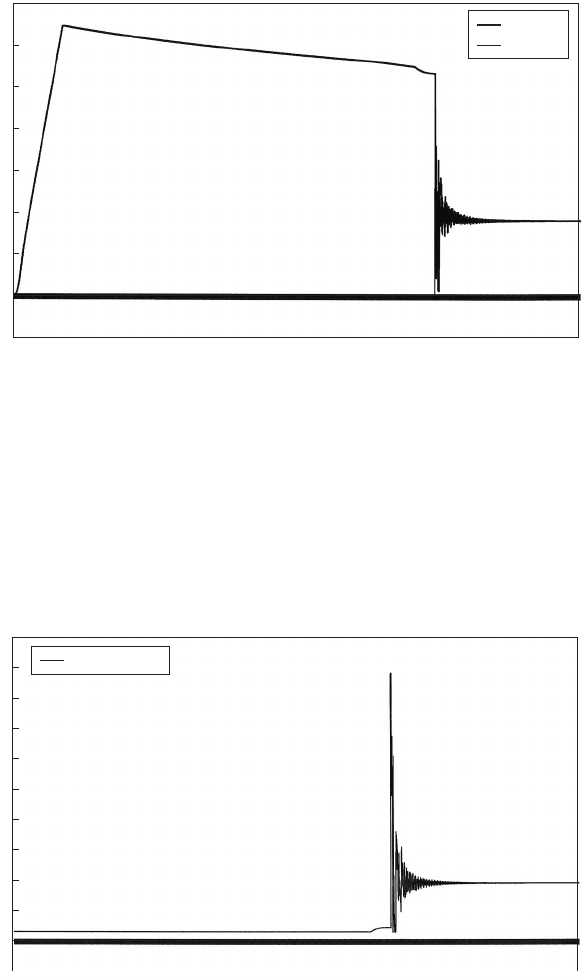
about 38 mAOD. The peak head of 180 mAOD influences the
pump delivery branch as far downstream as the 350/500 connection
(Fig. 18.3) and the head variations at the pump delivery, the air
valve connection and downstream of the NRV are shown in Fig. 18.8
for a time interval of 0.8 s around the time of air valve closure. Further
downstream in larger pipe diameters at the elevated air valve and at the
start of the rising main, velocity changes are smaller.
331
0.003
0.382
0.760
1.139
1.517
1.896
2.274
2.653
3.031
3.410
3.788
4.167
4.545
4.924
5.302
5.681
6.059
6.437
6.816
7.194
7.573
7.951
8.330
8.708
9.087
9.465
9.844
10.223
10.601
10.980
11.358
3.5
3.0
2.5
2.0
1.5
1.0
0.5
0.0
–0.5
Delivery
d/s NRV
Velocity (m/s)
Time (s)
AYR solo pump op/1 s start
Fig. 18.6. Velocity during/following riser filling
AV connection
Head (mAOD)
Time (s)
AYR solo pump op/1 s start
200
180
160
140
120
100
80
60
40
20
0
–20
0.003
0.422
0.840
1.258
1.677
2.095
2.513
2.932
3.350
3.768
4.187
4.605
5.023
5.441
5.860
6.278
6.696
7.115
7.533
7.951
8.370
8.788
9.206
9.625
10.043
10.462
10.880
11.298
11.717
12.135
12.554
Fig. 18.7. Head at the air valve after pump start
Air and gas
